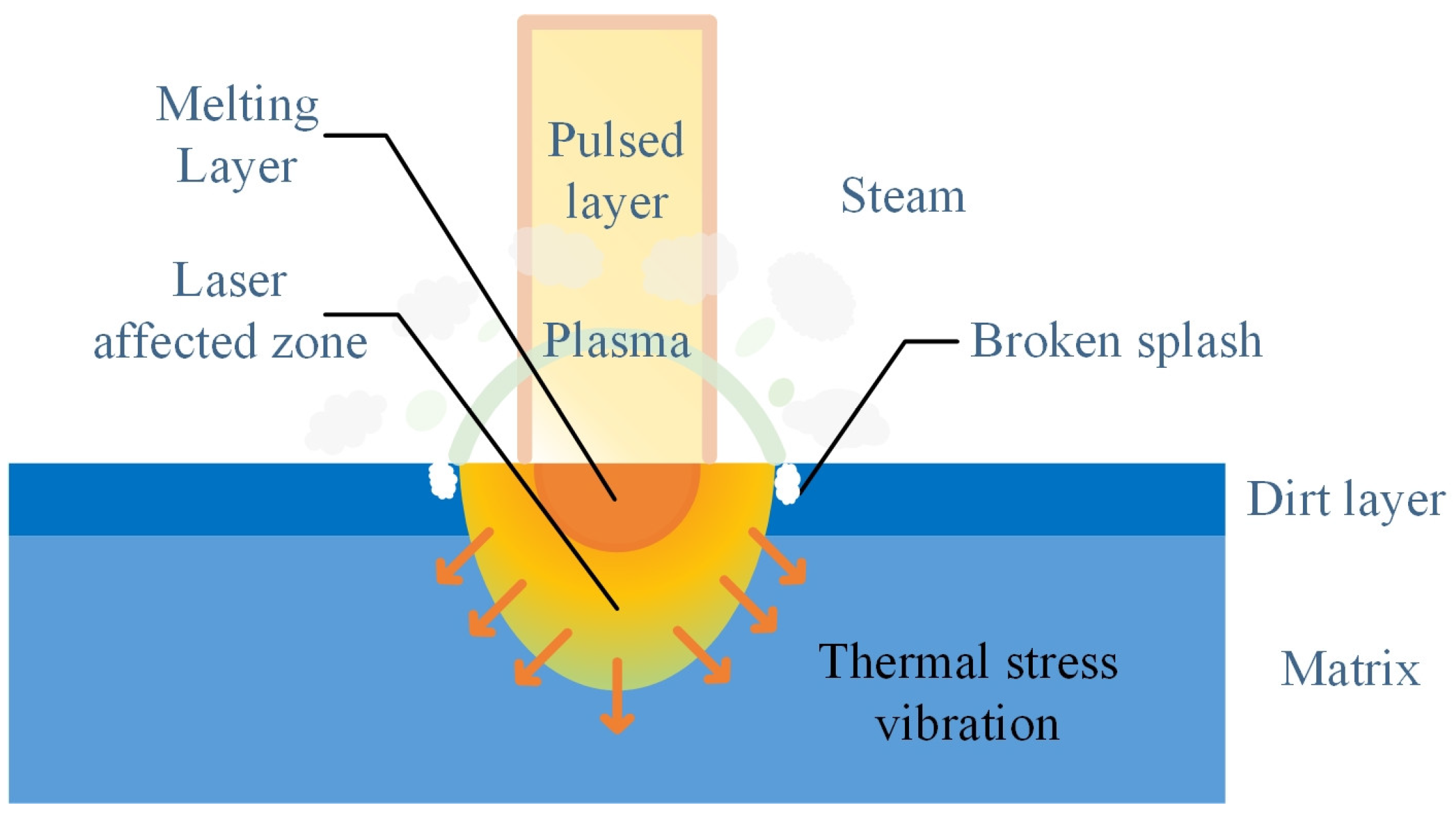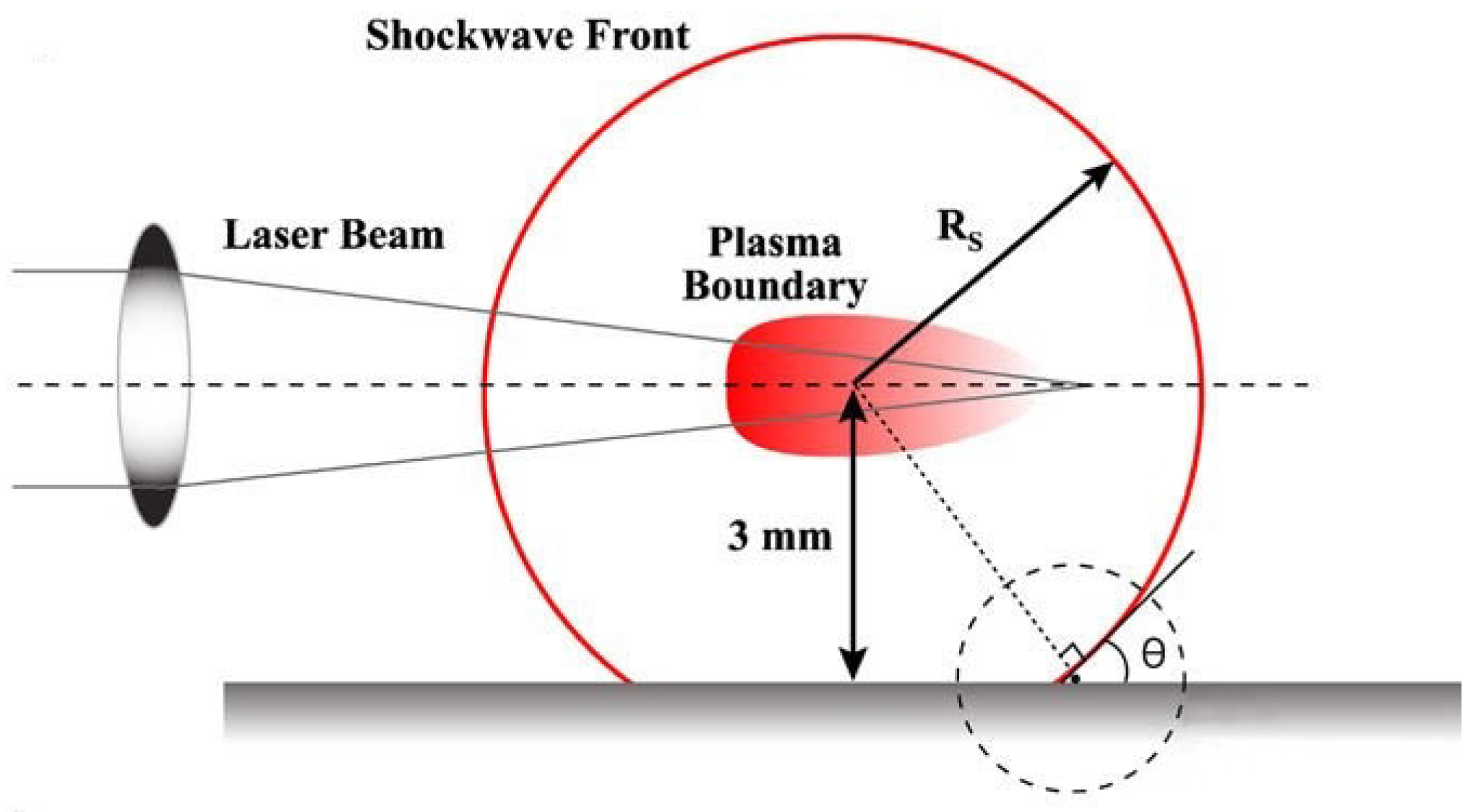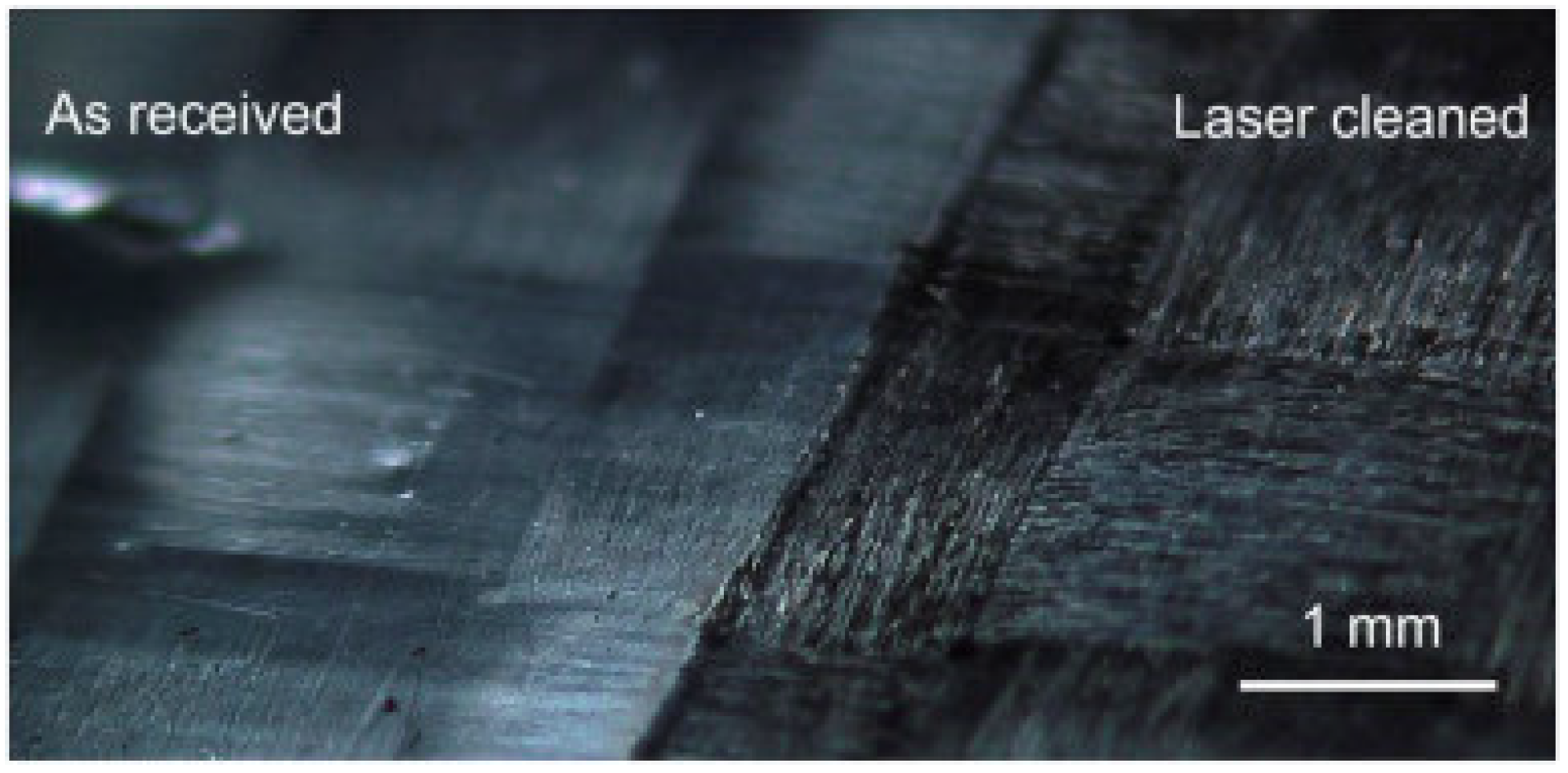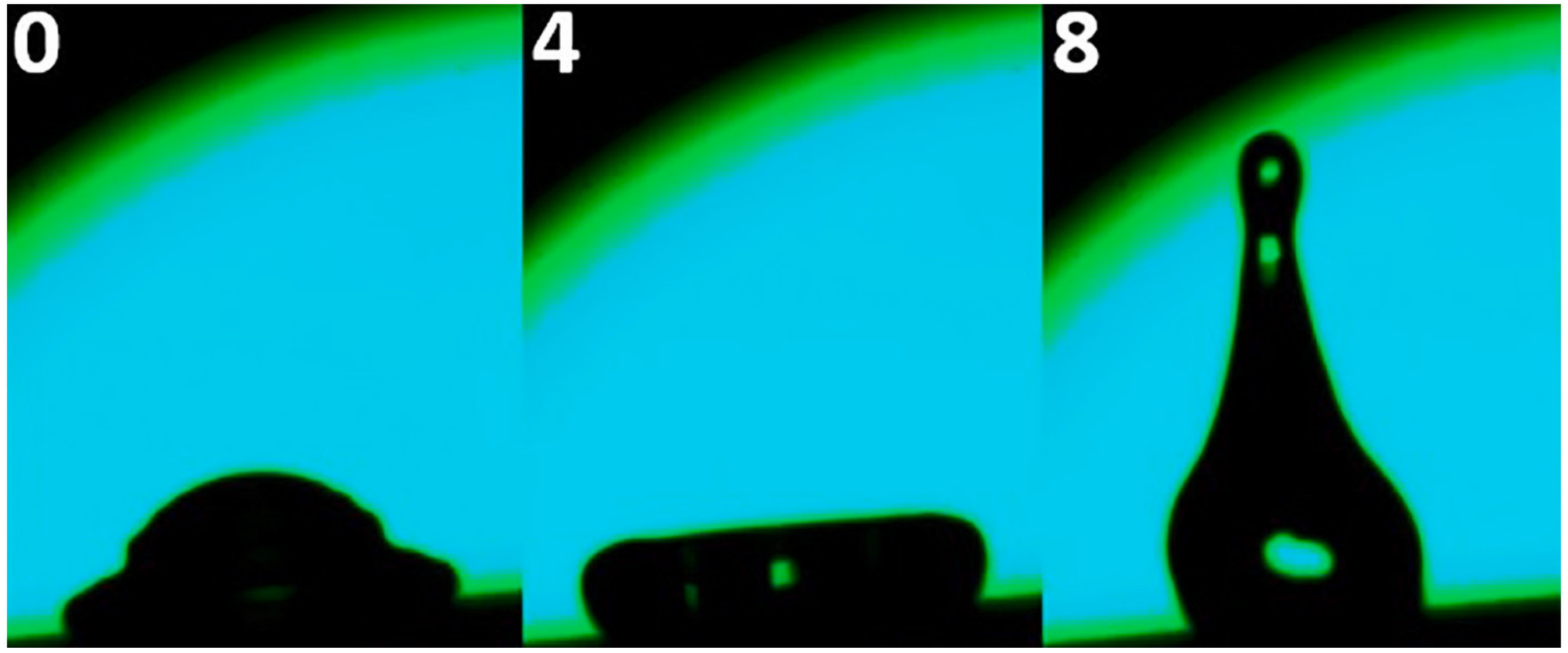The Fundamental Mechanisms of Laser Cleaning Technology and Its Typical Applications in Industry
Abstract
:1. Introduction
2. Laser Cleaning Mechanism
2.1. Laser Thermal Ablation Mechanism
2.2. Laser Thermal Stress Mechanism
- The laser’s intensity in the z-axis direction is assumed to follow the laser absorption law.
- The heat conduction depth in the z-axis direction is much smaller than the diameter of the laser beam spot.
- Both the coating and substrate are regarded as adiabatic.
- The laser beam profile is thought to have a flat-topped distribution on the plane.
2.3. Plasma Shock Wave Mechanism
3. Typical Applications of Laser Cleaning in Industrial Fields
3.1. Metallic Materials
3.1.1. Oil Film
3.1.2. Coating and Paint
3.1.3. Oxide Layer
3.2. Nonmetallic Materials
3.3. Semiconductor Element
3.4. Other Applications
4. Conclusions
- (1)
- The laser thermal ablation mechanism, the laser thermal stress mechanism, and the plasma shock wave mechanism can be expressed as evaporation processes, vibration processes, and impact processes, respectively. The laser thermal ablation mechanism and the laser thermal stress mechanism are the most common laser cleaning mechanisms. The common feature of the two mechanisms is that the pulse laser beam directly irradiates the surface. In the plasma shock wave mechanism, the laser beam is parallel to the surface of the substrate.
- (2)
- The laser cleaning mechanism is closely related to the laser wavelength; with a highly absorbent medium, the laser thermal ablation mechanism is dominant. With a less absorbent medium, the laser thermal stress mechanism is dominant.
- (3)
- Laser cleaning has unique advantages in many industrial fields. It can be used to remove most attachments from different substrate materials, such as metallic materials, nonmetallic materials, and semiconductor elements, and in other applications. By selecting suitable laser process parameters and the appropriate laser equipment, surface damage can be completely avoided.
- (4)
- In some scenarios, laser cleaning does not show an ideal cleaning effect. Complex or deep corrosion can be pretreated using mechanical and chemical cleaning methods. This can help to improve the cleaning result of the laser cleaning.
Author Contributions
Funding
Data Availability Statement
Conflicts of Interest
References
- Chen, Y.Z.; Hu, Y.H. Research and Application of ShipHull Fouling Cleaning Technologies. Surf. Technol. 2017, 46, 60–71. [Google Scholar]
- Ren, Y.; Wang, W.T.; Jin, S.; Wang, S.R.; Wang, G.Q.; Zhu, G.D.; Cheng, W.; Li, Y.L. Effect of Laser Cleaning on the Surface Properties of Aluminum Alloy Tire Mold. Appl. Laser 2020, 40, 901–906. [Google Scholar]
- Xu, C.Y.; Shi, X.K. On Efficiently Removing Micron and Submicron Particles from Super-Smooth Optical Substrate in P. R. China. J. Northwest. Polytech. Univ. 2002, 20, 128–131. [Google Scholar]
- Deng, J.; Zhao, G.; Lei, J.; Zhong, L.; Lei, Z. Research Progress and Challenges in Laser-Controlled Cleaning of Aluminum Alloy Surfaces. Materials 2022, 15, 5469. [Google Scholar] [CrossRef] [PubMed]
- Li, M. The Developments of Metal Cleaning. Lubr. Eng. 2009, 34, 105–109. [Google Scholar]
- Mason, T.J. Ultrasonic cleaning: An historical perspective. Ultrason. Sonochem. 2016, 29, 519–523. [Google Scholar] [CrossRef] [PubMed]
- Lu, M.; Zhang, M.; Zhang, J.; Gao, Z.; Hao, X. Advances in Research and Application of Laser Processing of Nonmetallic Composites. Aerosp. Mater. Technol. 2022, 52, 30–38. [Google Scholar]
- Tong, Y.; Ma, J.; Shangguan, J.; Jiang, B.; Ding, L.; Chen, L.; Wang, S. Research Progress of Laser Cleaning Technology for Aerospace Materials. Aeronaut. Manuf. Technol. 2022, 65, 48–56+69. [Google Scholar]
- Zhu, G.; Xu, Z.; Jin, Y.; Chen, X.; Yang, L.; Xu, J.; Shan, D.; Chen, Y.; Guo, B. Mechanism and application of laser cleaning: A review. Opt. Lasers Eng. 2022, 157, 107130. [Google Scholar] [CrossRef]
- Bedair, S.M.; Smith, H.P. Atomically Clean Surfaces by Pulsed Laser Bombardment. J. Appl. Phys. 1969, 40, 4776–4781. [Google Scholar] [CrossRef]
- Asmus, J.F.; Murphy, C.G.; Munk, W.H. Studies on The Interaction of Laser Radiation with Art Artifacts. In Society of Photo-Optical Instrumentation Engineers (SPIE) Conference Series; SPIE Digital Library: San Diego, CA, USA, 1974. [Google Scholar]
- Schweizer, G.; Werner, L. Industrial 2-kW TEA CO2 laser for paint stripping of aircraft. In Proceedings of the Gas Flow and Chemical Lasers: Tenth International Symposium, Friedrichshafen, Germany, 5–9 September 1994. [Google Scholar]
- Lee, J.M.; Watkins, K.G. Removal of Small Particles on Silicon Wafer by Laser-induced Airborne Plasma Shock Waves. J. Appl. Phys. 2001, 89, 6496–6500. [Google Scholar] [CrossRef]
- Chen, G.X.; Kwee, T.J.; Tan, K.P.; Choo, Y.S.; Hong, M. High-Power Fibre Laser Cleaning for Green Shipbuilding. J. Laser Micro Nanoeng. 2012, 7, 249–253. [Google Scholar] [CrossRef]
- Liu, P.F.; Wang, S.J.; Liu, Z.W.; Yin, F.S. Research Progress in Application of Laser Cleaning Technology. Mater. Prot. 2020, 53, 142–146. [Google Scholar]
- Lei, Z.L.; Tian, Z.; Chen, Y.B. Laser Cleaning Technology in Industrial Fields. Laser Optoelectron. Prog. 2018, 55, 60–72. [Google Scholar]
- Liu, Y.; Liu, W.J.; Zhang, D.; Tian, Z.; Sun, X.; Wei, Z. Experimental investigations into cleaning mechanism of ship shell plant surface involved in dry laser cleaning by controlling laser power. Appl. Phys. A 2020, 126, 866. [Google Scholar] [CrossRef]
- Grojo, D.; Cros, A.; Delaporte, P.; Sentis, M. Experimental investigation of ablation mechanisms involved in dry laser cleaning. Appl. Surf. Sci. 2007, 253, 8309–8315. [Google Scholar] [CrossRef]
- Hsu, H.T.; Lin, J. Thermal–mechanical analysis of the surface waves in laser cleaning. Int. J. Mach. Tools Manuf. 2005, 45, 979–985. [Google Scholar] [CrossRef]
- Kumar, A.; Prasad, M.; Bhatt, R.B.; Behere, P.G.; Biswas, D.J. A comparative study on laser induced shock cleaning of radioactive contaminants in air and water. Opt. Laser Technol. 2018, 100, 133–138. [Google Scholar] [CrossRef]
- Dimogerontakis, T.; Oltra, R.; Heintz, O. Thermal oxidation induced during laser cleaning of an aluminium-magnesium alloy. Appl. Phys. A 2005, 81, 1173–1179. [Google Scholar] [CrossRef]
- Pouli, P.; Selimis, A.; Georgiou, S.; Fotakis, C. Recent studies of laser science in paintings conservation and research. Acc. Chem. Res. 2010, 43, 771–781. [Google Scholar] [CrossRef] [PubMed]
- Pola, J.; Ouchi, A.; Bezdička, P.; Boháček, J.; Šubrt, J. Laser co-photolytic approach to copper(I) bromide/polymer nanosol and nanocomposite. J. Photochem. Photobiol. A Chem. 2007, 190, 29–33. [Google Scholar] [CrossRef]
- Chen, H.M.; Zhao, X.Y. Principles and Applications of Laser, 2nd ed.; Publishing House of Electronics Industry: Beijing, China, 2013; pp. 341–344. ISBN 978-7-121-21091-4. [Google Scholar]
- Tang, Q.H.; Zhou, D.; Wang, Y.L.; Liu, G.F. Laser cleaning of sulfide scale on compressor impeller blade. Appl. Surf. Sci. 2015, 355, 334–340. [Google Scholar] [CrossRef]
- Siano, S. Principles of laser cleaning in conservation. In Handbook on the Use of Lasers in Conservation and Conservation Science; Schreiner, M., Strlič, M., Salimbeni, R., Eds.; COST Office: Brussels, Belgium, 2008. [Google Scholar]
- Fox, J.A.; Barr, D.N. Laser-induced shock effects in Plexiglas and 6061-T6 aluminum. Appl. Phys. Lett. 1973, 22, 594–596. [Google Scholar] [CrossRef]
- Song, F.; Zou, W.F.; Tian, B.; Liu, S.J.; Niu, K.Z.; Li, X.P.; Tian, J.G. Model of One-Dimensional Thermal Stress Applied in Paint Removal by Q-Switched Short Pulse Laser. Chin. J. Lasers 2007, 34, 1577–1581. [Google Scholar]
- Lu, Y.; Yang, L.; Wang, M.; Wang, Y. Simulation of nanosecond laser cleaning the paint based on the thermal stress. Optik 2021, 227, 165589. [Google Scholar] [CrossRef]
- Steen, W.M.; Mazumder, J. Laser Material Processing, 4th ed.; Springer: London, UK, 2010; pp. 417–440. ISBN 978-1-84996-061-8. [Google Scholar]
- Kim, T.G.; Yoo, Y.S.; Lee, S.H.; Park, J.G. Effects of size, humidity, and aging on particle removal from Si wafers. Microelectron. Eng. 2009, 86, 145–149. [Google Scholar] [CrossRef]
- Kumar, A.; Prasad, M.; Bhatt, R.B.; Behere, P.G.; Afzal, M.; Kumar, A.; Nilaya, J.P.; Biswas, D.J. Laser shock cleaning of radioactive particulates from glass surface. Opt. Lasers Eng. 2014, 57, 114–120. [Google Scholar] [CrossRef]
- Razab, M.K.A.A.; Mohamed Noor, A.A.; Suhaimi Jaafar, M.; Abdullah, N.H.; Suhaimi, F.M.; Mohamed, M.; Adam, N.; Auli Nik Yusuf, N.A. A review of incorporating Nd:YAG laser cleaning principal in automotive industry. J. Radiat. Res. Appl. Sci. 2018, 11, 393–402. [Google Scholar] [CrossRef]
- Song, W.D.; Hong, M.H.; Lu, Y.F.; Chong, T.C. Laser cleaning of printed circuit boards. Appl. Surf. Sci. 2003, 208–209, 463–467. [Google Scholar] [CrossRef]
- Yin, C.H.; Chen, X.K.; Luo, X.P. Application prospect of laser cleaning in petrochemical field. Opto-Electron. Eng. 2020, 47, 3–15. [Google Scholar]
- Ahn, D.; Jang, D.; Park, T.; Kim, D. Laser removal of lubricating oils from metal surfaces. Surf. Coat. Technol. 2012, 206, 3751–3757. [Google Scholar] [CrossRef]
- AlShaer, A.W.; Li, L.; Mistry, A. The effects of short pulse laser surface cleaning on porosity formation and reduction in laser welding of aluminium alloy for automotive component manufacture. Opt. Laser Technol. 2014, 64, 162–171. [Google Scholar] [CrossRef]
- Gao, K.; Zeng, Q.S.; Zhang, Z.Y.; Lin, X.C. Adhesion of Residual Primer Paint After Laser Cleaning Aircraft Aluminum Alloy Skin. Laser Optoelectron. Prog. 2021, 58, 296–302. [Google Scholar]
- Liu, W.J.; Zhang, M.Q.; Li, Q.; Bian, H.Y.; Zhao, Z.M.; Zhang, D. Effect of Laser Cleaning Process Parameters on Surface Paint Removal of TC4 Titanium Alloy. Chin. J. Lasers 2023, 50, 101–109. [Google Scholar]
- Wan, Z.; Yang, X.F.; Xia, G.F.; Li, D.; Liu, W.B.; Cheng, J.; Wang, S.R. Effect of Laser Frequency on the Mechanism and Performance of Laser Dry Cleaning. Surf. Technol. 2021, 50, 70–77. [Google Scholar]
- Bertasa, M.; Korenberg, C. Successes and challenges in laser cleaning metal artefacts: A review. J. Cult. Herit. 2022, 53, 100–117. [Google Scholar] [CrossRef]
- Zhu, L.; Gao, Q.; Sun, B.; Ke, Y.; Tan, Y.; Cao, Y. Nanosecond laser cleaning for enhanced zinc coating quality of HSLA steel. Opt. Laser Technol. 2021, 143, 107311. [Google Scholar] [CrossRef]
- Li, W.M.; Jiang, J.B.; Liu, F.F.; Jiang, K. Cleaning process of TA2 cladding surface of titanium steel composite plate. J. Mater. Metall. 2022, 21, 358–363. [Google Scholar]
- Atanassova, V.; Kostadinov, I.; Karatodorov, S.; Avdeev, G.; Penkova, P. Laser removal of chlorine from historical metallic objects. In Proceedings of the 20th International Conference and School on Quantum Electronics: Laser Physics and Applications, Nessebar, Bulgaria, 17–21 September 2018. [Google Scholar]
- Prokuratov, D.S.; Davtian, A.S.; Vereshchagin, O.S.; Kurganov, N.S.; Samokhvalov, A.A.; Pankin, D.V.; Povolotckaia, A.V.; Shimko, A.A.; Mikhailova, A.A.; Somov, P.A.; et al. Laser cleaning of archaeologically corroded iron objects with inlays. Opt. Quantum Electron. 2020, 52, 113. [Google Scholar] [CrossRef]
- Ren, M.X.; Guan, P.W.; Xu, P.; Deng, J.Y.; Liu, Y.; Wu, X.Y.; Wang, S.J.; Ji, Y.P. Research on cleaning technology of electrical insulators by MOPA pulsed fiber laser. Laser Technol. 2022, 46, 648–652. [Google Scholar]
- Barnier, F.; Dyer, P.E.; Monk, P.; Rourke, H. Fibre optic jacket removal by pulsed laser ablation. J. Phys. D Appl. Phys. 2000, 33, 757. [Google Scholar] [CrossRef]
- Weng, T.S.; Tsai, C.H. Laser-induced backside wet cleaning technique for glass substrates. Appl. Phys. A 2014, 116, 597–604. [Google Scholar] [CrossRef]
- Pozo-Antonio, J.S.; Rivas, T.; López, A.J.; Fiorucci, M.P.; Ramil, A. Effectiveness of granite cleaning procedures in cultural heritage: A review. Sci. Total Environ. 2016, 571, 1017–1028. [Google Scholar] [CrossRef]
- Genna, S.; Lambiase, F.; Leone, C. Effect of laser cleaning in Laser Assisted Joining of CFRP and PC sheets. Compos. Part B Eng. 2018, 145, 206–214. [Google Scholar] [CrossRef]
- Zhang, J.B.; Zhang, K.H.; Fan, H.T.; Lu, M.Y.; Gao, Z.; Zhang, X.H. Progress in laser processing of fiber composite materials and prospects of its applications in aerospace. Acta Aeronaut. Astronaut. Sin. 2022, 43, 135–153. [Google Scholar]
- Yokozeki, T.; Ishibashi, M.; Kobayashi, Y.; Shamoto, H.; Iwahori, Y. Evaluation of adhesively bonded joint strength of CFRP with laser treatment. Adv. Compos. Mater. 2015, 25, 317–327. [Google Scholar] [CrossRef]
- Georgiou, S. Laser Cleaning Methodologies of Polymer Substrates. In Polymers and Light; Lippert, T.K., Ed.; Springer: Berlin/Heidelberg, Germany, 2004; pp. 1–50. [Google Scholar]
- Zhang, X.; Chen, Y.H. Research Progress and Prospect of Application of Different Types Laser in Laser Cleaning Technology. Hot Work. Technol. 2016, 45, 37–40. [Google Scholar]
- Bäuerle, D. Laser processing and chemistry: Recent developments. Appl. Surf. Sci. 2002, 186, 1–6. [Google Scholar] [CrossRef]
- Neves, P.; Arronte, M.; Vilar, R.; Botelho do Rego, A.M. KrF excimer laser dry and steam cleaning of silicon surfaces with metallic particulate contaminants. Appl. Phys. A 2002, 74, 191–199. [Google Scholar] [CrossRef]
- Lee, S.H.; Park, J.G.; Lee, J.M.; Cho, S.H.; Cho, H.K. Si wafer surface cleaning using laser-induced shock wave: A new dry cleaning methodology. Surf. Coat. Technol. 2003, 169–170, 178–180. [Google Scholar] [CrossRef]
- Kim, T.G.; Yoo, Y.S.; Kim, T.G.; Ahn, J.; Lee, J.M.; Choi, J.S.; Busnaina, A.; Park, J.G. Damage Free Particle Removal from Extreme Ultraviolet Lithography Mask Layers by High Energy Laser Shock Wave Cleaning. Jpn. J. Appl. Phys. 2008, 47, 4886–4889. [Google Scholar] [CrossRef]
- Lai, Q.; Feng, G.; Yan, J.; Han, J.; Zhang, L.; Ding, K. Damage threshold of substrates for nanoparticles removal using a laser-induced plasma shockwave. Appl. Surf. Sci. 2021, 539, 148282. [Google Scholar] [CrossRef]
- Liu, L.T.; Wang, C.L.; Yu, X.Y.; Shi, J.K.; Li, Y.; Chen, X.M.; Zhou, W.H. Study of nano particle stripping and composition inspection on wafer surface. Acta Phys. Sin. 2020, 69, 181–188. [Google Scholar] [CrossRef]
- Guo, J.B.; Ma, J.; Gao, Y.; Jiang, B.; Lu, J.Y.; Han, J.J.; Tong, Y.Q. Application of Laser Cleaning Technology in Nuclear and Biochemical Decontamination. Appl. Laser 2022, 42, 101–107. [Google Scholar]
- Roberts, D.E.; Modise, T.S. Laser removal of loose uranium compound contamination from metal surfaces. Appl. Surf. Sci. 2007, 253, 5258–5267. [Google Scholar] [CrossRef]
- Kosters, M.; Sturman, B.; Haertle, D.; Buse, K. Optical cleaning of lithium niobate crystals. In Proceedings of the CLEO/Europe-EQEC 2009-European Conference on Lasers and Electro-Optics and the European Quantum Electronics Conference, Munich, Germany, 14–19 June 2009; p. 1. [Google Scholar]
- Scholten, H.; Schipper, D.; Ligterink, F.J.; Pedersoli, J.L.; Rudolph, P.; Kautek, W.; Havermans, J.B.G.A.; Aziz, H.A.; van Beek, B.; Kraan, M.; et al. Laser cleaning investigations of paper models and original objects with Nd:YAG and KrF laser systems. In Springer Proceedings in Physics; Springer: Berlin/Heidelberg, Germany, 2005; Volume 100, pp. 11–18. [Google Scholar]
- Josic, U.; Mazzitelli, C.; Maravić, T.; Fidler, A.; Breschi, L.; Mazzoni, A. Biofilm in Endodontics: In Vitro Cultivation Possibilities, Sonic-, Ultrasonic- and Laser-Assisted Removal Techniques and Evaluation of the Cleaning Efficacy. Polymers 2022, 14, 1334. [Google Scholar] [CrossRef]
- Martinez-Calderon, M.; Haase, T.A.; Novikova, N.I.; Wells, F.S.; Low, J.; Willmott, G.R.; Broderick, N.G.R.; Aguergaray, C. Turning industrial paints superhydrophobic via femtosecond laser surface hierarchical structuring. Prog. Org. Coat. 2022, 163, 106625. [Google Scholar] [CrossRef]
- Ravi-Kumar, S.; Lies, B.; Lyu, H.; Qin, H. Laser Ablation of Polymers: A Review. Procedia Manuf. 2019, 34, 316–327. [Google Scholar] [CrossRef]
- Zhang, L.; Sun, Y.N.; Wang, G.J.; Li, T.T. Progress in Research and Application of Femtosecond Laser in Industry. Hot Work. Technol. 2020, 49, 20–24. [Google Scholar]
- Obilor, A.F.; Pacella, M.; Wilson, A.; Silberschmidt, V.V. Micro-texturing of polymer surfaces using lasers: A review. Int. J. Adv. Manuf. Technol. 2022, 120, 103–135. [Google Scholar] [CrossRef]












Disclaimer/Publisher’s Note: The statements, opinions and data contained in all publications are solely those of the individual author(s) and contributor(s) and not of MDPI and/or the editor(s). MDPI and/or the editor(s) disclaim responsibility for any injury to people or property resulting from any ideas, methods, instructions or products referred to in the content. |
© 2023 by the authors. Licensee MDPI, Basel, Switzerland. This article is an open access article distributed under the terms and conditions of the Creative Commons Attribution (CC BY) license (https://creativecommons.org/licenses/by/4.0/).
Share and Cite
Zhou, Z.; Sun, W.; Wu, J.; Chen, H.; Zhang, F.; Wang, S. The Fundamental Mechanisms of Laser Cleaning Technology and Its Typical Applications in Industry. Processes 2023, 11, 1445. https://doi.org/10.3390/pr11051445
Zhou Z, Sun W, Wu J, Chen H, Zhang F, Wang S. The Fundamental Mechanisms of Laser Cleaning Technology and Its Typical Applications in Industry. Processes. 2023; 11(5):1445. https://doi.org/10.3390/pr11051445
Chicago/Turabian StyleZhou, Zhihu, Weipeng Sun, Jiajun Wu, Hongwei Chen, Fei Zhang, and Shuangxi Wang. 2023. "The Fundamental Mechanisms of Laser Cleaning Technology and Its Typical Applications in Industry" Processes 11, no. 5: 1445. https://doi.org/10.3390/pr11051445
APA StyleZhou, Z., Sun, W., Wu, J., Chen, H., Zhang, F., & Wang, S. (2023). The Fundamental Mechanisms of Laser Cleaning Technology and Its Typical Applications in Industry. Processes, 11(5), 1445. https://doi.org/10.3390/pr11051445






